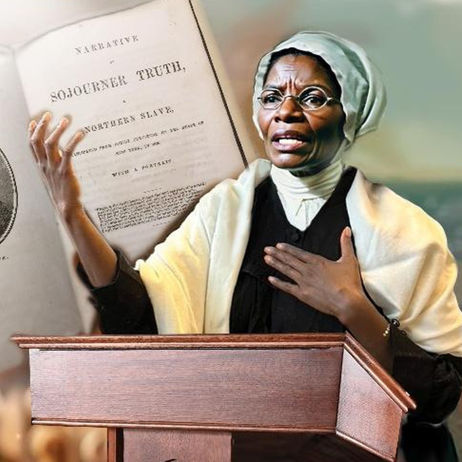
LEIGH BROOKLYN
The Story of Sojourner Truth
The Story of Sojourner Truth
Leigh
Brooklyn
the artist's inspiration
The founding of the United States of America set a big ambition for what the country can be – but from the beginning a truth of its reality is that it has always taken people to bring the nation’s ideals closer to being. And the harsh truth is that so often it is people who did not experience the presence of those ideals in their lives that have had to sacrifice and shoulder the greatest burden in order to give those ideals greater meaning.
One of those people is the iconic abolitionist and feminist Sojourner Truth. She was born as Isabella Baumfree in Swartekill, New York in around 1797. Enslaved from birth, her father was enslaved, trafficked from present-day Ghana, while her mother was the daughter of enslaved people trafficked from Guinea.
Her brother and sister were sold to different estates. Her first language was Dutch, and she would speak with a Dutch accent for the rest of her life. She was sold a number of times to different slavers across New York state, enduring sexual assault over decades. She had also married an enslaved man named Thomas, with whom she had children.
The first picture depicts her escape to freedom with her infant daughter, Sophia, in late 1826. She found her way to the home of Isaac and Maria Van Wagenen, who took them in and supported her by paying off her enslaver for the time before the New York State Emancipation Act took effect the next year.
The second portrait shows her standing with her son, Peter. Then five years old, Peter had been illegally sold to a slaver in Alabama. With support from the Van Wagenens, she took the case to the New York Supreme Court. In 1828, after months of legal proceedings, she got Peter back, who had been abused by her owners. She was one of the first Black women to go to court against a white man and win.
It was around this time that she became a Christian, co-founding the Methodist church of Kingston, NY, before joining the John Street Methodist Church – represented in the background here – when she moved to New York City in 1829.
1843 was a key year in her life. She changed her name to Sojourner Truth –choosing the name as she had heard the Spirit of God calling on her to preach the truth. As she told people “The Spirit calls me, and I must go”. She went on to travel far and wide to preach about the abolition of slavery, drawing large crowds to her speaking and singing. She met other leading abolitionists such as Frederick Douglass, David Ruggles and William Lloyd Garrison, who encouraged her to step further into the work. Truth dictated her memoirs to her friend Oliver Gilbert and Garrison privately published her book The Narrative of Sojourner Truth: a Northern Slave in 1850 – the book you can see in the background. She was then able to buy a home and she spoke at the first National Women’s Rights Convention.
CAPITOL PARK, detroit
june 2024


All this is an important background to the final portrait on the sculpture, which is Truth delivering an iconic speech at the Ohio Women’s Rights Convention in Akron, Ohio in 1851. Her speech demanded equal human rights for all women and combined calls for abolitionism with women’s rights. The speech became known as the “Ain’t I a Woman?” because in the best known account, that question was repeated four times. One of the things that is interesting is that the accounts of her words vastly differ – and the version with that title is highly unlikely, as it is written in the cadence of enslaved people in the South, when Truth had a distinct Dutch accent. But yet her speech has echoed down generations as a powerful call for the women’s movement to champion the broad interests of all humanity.
These are only small snapshots of an incredibly full life. There could have been countless moments depicted from Truth’s life fighting for a more equal society: recruiting Black troops for the Union Army; being invited to the White House by Presidents Abraham Lincoln and Ulysses S. Grant; helping to force the desegregation of streetcars in DC; and so much more activism until she passed away in 1883.
There is so much more to discover about this extraordinary woman – I hope you will seek out the full story of her life. The life of Sojourner Truth tells us so clearly that one person – even facing odds we can’t really imagine in the modern world – can grab that arc of history and bend it towards justice. Because after all, the person who said “Ain’t I A Woman?” was just that: not born an icon, but simply a woman, who made decision after courageous decision to bring the world she wanted to see closer to being.
Leigh’s “If I Could Tell You Just One Thing…”
Don’t let anyone tell you that you cannot achieve something. It might take a lot of time and a lot of work; there might be several hurdles and set-backs along the way but if you keep working toward what you want in life you'll be amazed at how far you can go. Grit and determination are some of the greatest predictors of your success.
THEME
WE HOLD THESE TRUTHS
We Hold These Truths asks us to consider the contrasts between the high ideals and the reality of oppression and enslavement of the founding and early formation of the United States.
THEME
We hold these truths
We Hold These Truths asks us to consider the contrasts between the high ideals and the reality of oppression and enslavement of the founding and early formation of the United States.
the artist's inspiration
The founding of the United States of America set a big ambition for what the country can be – but from the beginning a truth of its reality is that it has always taken people to bring the nation’s ideals closer to being. And the harsh truth is that so often it is people who did not experience the presence of those ideals in their lives that have had to sacrifice and shoulder the greatest burden in order to give those ideals greater meaning.
One of those people is the iconic abolitionist and feminist Sojourner Truth. She was born as Isabella Baumfree in Swartekill, New York in around 1797. Enslaved from birth, her father was enslaved, trafficked from present-day Ghana, while her mother was the daughter of enslaved people trafficked from Guinea.
Her brother and sister were sold to different estates. Her first language was Dutch, and she would speak with a Dutch accent for the rest of her life. She was sold a number of times to different slavers across New York state, enduring sexual assault over decades. She had also married an enslaved man named Thomas, with whom she had children.
The first picture depicts her escape to freedom with her infant daughter, Sophia, in late 1826. She found her way to the home of Isaac and Maria Van Wagenen, who took them in and supported her by paying off her enslaver for the time before the New York State Emancipation Act took effect the next year.
The second portrait shows her standing with her son, Peter. Then five years old, Peter had been illegally sold to a slaver in Alabama. With support from the Van Wagenens, she took the case to the New York Supreme Court. In 1828, after months of legal proceedings, she got Peter back, who had been abused by her owners. She was one of the first Black women to go to court against a white man and win.

LEIGH BROOKLYN
Leigh earned her degree in Biomedical Illustration from the Cleveland Institute of Art and worked with several hospitals, museums, and research facilities. In 2011 she began moving throughout the US pursuing street photography, switching her focus back to figurative art and oil painting. In 2019 Brooklyn began learning techniques for sculpture. In 2021 She earned her certification in welding and in 2023 began an apprenticeship learning traditional and modern techniques for stone carving and masonry. Brooklyn has won countless national and international awards. Most recently in 2023 she won the American Illustration Award in New York City. Her work has been displayed in galleries, museums, and art fairs across the country.

Let's make our shared ideals a reality. For everyone.
It was around this time that she became a Christian, co-founding the Methodist church of Kingston, NY, before joining the John Street Methodist Church – represented in the background here – when she moved to New York City in 1829.
1843 was a key year in her life. She changed her name to Sojourner Truth –choosing the name as she had heard the Spirit of God calling on her to preach the truth. As she told people “The Spirit calls me, and I must go”. She went on to travel far and wide to preach about the abolition of slavery, drawing large crowds to her speaking and singing. She met other leading abolitionists such as Frederick Douglass, David Ruggles and William Lloyd Garrison, who encouraged her to step further into the work. Truth dictated her memoirs to her friend Olilver Gilbert and Garrison privately published her book The Narrative of Sojourner Truth: a Northern Slave in 1850 – the book you can see in the background. She was then able to buy a home and she spoke at the first National Women’s Rights Convention.
All this is an important background to the final portrait on the sculpture, which is Truth delivering an iconic speech at the Ohio Women’s Rights Convention in Akron, Ohio in 1851. Her speech demanded equal human rights for all women and combined calls for abolitionism with women’s rights. The speech became known as the “Ain’t I a Woman?” because in the best known account, that question was repeated four times. One of the things that is interesting is that the accounts of her words vastly differ – and the version with that title is highly unlikely, as it is written in the cadence of enslaved people in the South, when Truth had a distinct Dutch accent. But yet her speech has echoed down generations as a powerful call for the women’s movement to champion the broad interests of all humanity.
These are only small snapshots of an incredibly full life. There could have been countless moments depicted from Truth’s life fighting for a more equal society: recruiting Black troops for the Union Army; being invited to the White House by Presidents Abraham Lincoln and Ulysses S. Grant; helping to force the desegregation of streetcars in DC; and so much more activism until she passed away in 1883.
There is so much more to discover about this extraordinary woman – I hope you will seek out the full story of her life. The life of Sojourner Truth tells us so clearly that one person – even facing odds we can’t really imagine in the modern world – can grab that arc of history and bend it towards justice. Because after all, the person who said “Ain’t I A Woman?” was just that: not born an icon, but simply a woman, who made decision after courageous decision to bring the world she wanted to see closer to being.
Leigh’s “If I Could Tell You Just One Thing…”
Don’t let anyone tell you that you cannot achieve something. It might take a lot of time and a lot of work; there might be several hurdles and set-backs along the way but if you keep working toward what you want in life you'll be amazed at how far you can go. Grit and determination are some of the greatest predictors of your success.
explore the theme
Let's make our shared ideals a reality. For everyone.
LEIGH BROOKLYN
Leigh earned her degree in Biomedical Illustration from the Cleveland Institute of Art and worked with several hospitals, museums, and research facilities. In 2011 she began moving throughout the US pursuing street photography, switching her focus back to figurative art and oil painting. In 2019 Brooklyn began learning techniques for sculpture. In 2021 She earned her certification in welding and in 2023 began an apprenticeship learning traditional and modern techniques for stone carving and masonry. Brooklyn has won countless national and international awards. Most recently in 2023 she won the American Illustration Award in New York City. Her work has been displayed in galleries, museums, and art fairs across the country.

For everyone. For you. By all of us. Join us.
For everyone. For you.
By all of us. Join us.

PURPOSE
in our relationship with ourselves.
WORTHINESS
I am worthy of love dignity and respect.
AWARENESS
I know how I see the world and where it comes from.
BELIEF
I believe I have something valuable to offer.
PURPOSE
I know what inspires me and what I want to do.




















